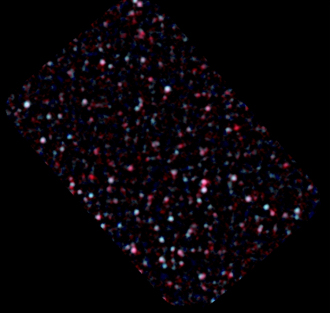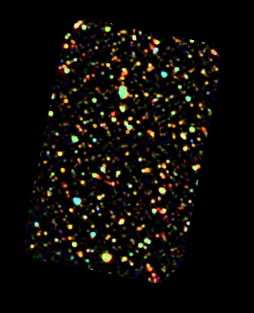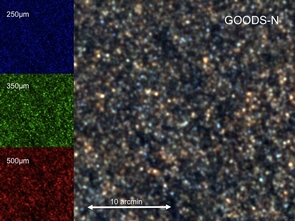Herschel reveals galaxies in the GOODS fields in a brand new light
6 May 2010
The discovery of a previously unresolved population of galaxies in the GOODS fields and the first measurements of properties of galaxies in the almost unexplored far-infrared domain are among the first exciting scientific results achieved by Herschel's PACS and SPIRE instruments. These findings confirm the extraordinary capabilities of ESA's new infrared space observatory to investigate the formation and evolution of galaxies.These are some of the many discoveries presented this week at the Herschel First Results Symposium, ESLAB 2010, held at the European Space Research and Technology Centre, Noordwijk, The Netherlands.
Understanding the details of how galaxies formed and evolved throughout cosmic history is one of the main goals of current astrophysical research. ESA's Herschel space observatory has begun to address this issue by joining in GOODS - the Great Observatories Origins Deep Survey - an ambitious project conceived to shed new light on this open topic.
Two carefully selected regions of the northern and southern sky, centred on the Hubble Deep Field North and the Chandra Deep Field South, have been the target of deep surveys conducted during the past decade over an extremely broad wavelength range, by means of ESA's and NASA's space observatories and the foremost ground-based telescopes. The GOODS fields, each measuring 10 by 16 arc minutes, are ideal for studying galaxies out to very high redshifts, as they do not contain any bright star and are not contaminated by strong emission coming from the Milky Way.
"Although both GOODS fields have been the object of extensive observations in the past, they have not been explored in the far-infrared region of the electromagnetic spectrum at the level that can be achieved by Herschel," explains Göran Pilbratt, Herschel Project Scientist. "Exploiting Herschel's powerful infrared eye and its broad wavelength coverage, we are now in the process of revealing some of the secrets that have been concealed until now."
 |
 |
| GOODS-North (left) and GOODS-South (right) as viewed by PACS. Credit: ESA/PACS Consortium/PEP Key Programme Consortium |
|
In October 2009, the Photodetector Array Camera & Spectrograph (PACS) and the Spectral Imaging and Photometric Receiver (SPIRE) aboard Herschel observed the GOODS-North field. Three months later it was the turn of the GOODS-South field to be scrutinised by PACS. These PACS and SPIRE observations have yielded the most sensitive images yet obtained by Herschel. Thanks to these highly sensitive instruments and to the telescope's large mirror, astronomers have been able, for the first time, to pinpoint a large fraction of the galaxies responsible for a diffuse light emission in the infrared, the so-called Cosmic Infrared Background (CIB).
The CIB is a relic, isotropic emission distinct from the Cosmic Microwave Background (CMB) and is associated with the formation of galaxies. Predicted in the mid-1960s, it was first detected, only 30 years later, with the Cosmic Background Explorer (COBE). The CIB is particularly hard to probe, as all galaxies at all redshifts contribute to it and hence it has no characteristic signature.
Infrared observations carried out with the ISO and Spitzer space telescopes already detected a handful of galaxies producing part of this background radiation, in the mid-infrared, but they could not access the bulk of it. "Since the CIB peaks around 100-200 microns, the majority of the galaxies contributing to this emission remained unidentified in the pre-Herschel era," says Dieter Lutz from the Max Planck Institute for extraterrestrial Physics and leader of the PACS Evolutionary Probe Key Programme which includes the GOODS fields amongst its targets.
With both the wavelength coverage and the technical characteristics required to resolve this 'cosmic fog' into individual galaxies, Herschel's PACS has isolated the sources of about a half of the CIB in the GOODS fields. "Thanks to the wealth of complementary data available for these fields, we have also studied how many of these galaxies are to be found at various epochs in cosmic history," adds Stefano Berta, who led this study. In fact, most of these galaxies are located at relatively low redshifts (z<1), their light having travelled less than 8000 million years before reaching us.
 |
| GOODS-N as viewed by SPIRE. Credit: ESA/SPIRE Consortium/ HerMES Key Programme Consortium |
In peering into the GOODS-North field, SPIRE has yielded the first observations of this region of the sky at this instrument's characteristic wavelengths (250-500 microns). This new spectral window allows astronomers to look at star-forming galaxies at even higher redshifts. These are normally hidden from observations at shorter wavelengths because most of the energy emitted in star formation processes is absorbed by dust and re-emitted in the far-infrared domain.
"We know that the energy we receive from galaxies directly is roughly as much as the energy we receive from them after it has been reprocessed by dust," says Seb Oliver from the University of Sussex and leader of the HerMES Key Programme which probes galaxy evolution. "Thanks to SPIRE and PACS, we can finally explore how the population of obscured galaxies has evolved over cosmic time."
The true power of Herschel is unleashed when the images from both instruments are studied together. As a result of this synergy, observations of galaxies made by SPIRE on the GOODS-North field complement the studies on the CIB performed with PACS data. "A significant fraction of galaxies contributing to the CIB has also been resolved by SPIRE," comments Oliver. "This population of galaxies is dominated by sources at z~1, demonstrating that most of the infrared background radiation is emitted at low redshifts," adds Steve Eales from Cardiff University.
By sampling galaxies at the peak of their far-infrared emission, Herschel allows also a better understanding of the star-forming processes taking place within them. "The properties of galaxies in these new PACS and SPIRE images appear surprisingly uniform over the last 10 billion years of cosmic history, even for those galaxies harbouring an active nucleus," says David Elbaz from Laboratoire AIM-Paris-Saclay. This finding suggests that the history of star formation in the Universe is governed by simple, universal mechanisms. "This is only a first step, since a new window on the GOODS fields has just been opened with the GOODS-Herschel Open Time Key Programme. This will push Herschel to its ultimate limits in terms of depth," adds Elbaz.
And it is clear that much more is in store when placing Herschel data in the broader context of the wider electromagnetic spectrum. Some interesting results have already arisen when comparing Herschel data with radio observations of the GOODS-North field performed by the Very Large Array. "We have revealed tantalising signs of an evolution of the famous (and surprisingly strong) correlation between infrared emission and radio emission," notes Rob Ivison from UK Astronomy Technology Centre at the Royal Observatory in Edinburgh.
Notes to Editors
Herschel is an ESA space observatory with science instruments provided by European-led Principal Investigator consortia, with important participation from NASA.
PACS is an imaging photometer and integral field line spectrometer covering wavelengths between 57 and 210 µm. PACS was built by a consortium of institutes and university departments from across Europe, and is led by Albrecht Poglitsch of the Max-Planck-Institute for Extraterrestrial Physics, Garching, Germany. Consortium members are: UVIE (Austria); KUL, CSL, IMEC (Belgium); CEA, OAMP (France); MPIA (Germany); IFSI, OAP/AOT, OAA/CAISMI, LENS, SISSA (Italy); IAC (Spain). This development has been supported by the funding agencies BMVIT (Austria), ESA-PRODEX (Belgium), CEA/CNES (France), DLR (Germany), ASI (Italy), and CICYT/MCYT (Spain)
The SPIRE instrument comprises an imaging photometer (camera) and an imaging spectrometer. The camera operates in three wavelength bands centred on 250, 350 and 500 μm, and so can make images of the sky simultaneously in three submillimetre "colours". The spectrometer covers the range 200 – 670 μm, allowing the spectral features of atoms and molecules to be measured. SPIRE has been developed by a consortium of institutes led by Cardiff Univ. (UK) and including Univ. Lethbridge (Canada); NAOC (China); CEA, LAM (France); IFSI, Univ. Padua (Italy); IAC (Spain); Stockholm Observatory (Sweden); Imperial College London, RAL, UCL-MSSL, UKATC, Univ. Sussex (UK); Caltech, JPL, NHSC, Univ. Colorado (USA). This development has been supported by national funding agencies: CSA (Canada); NAOC (China); CEA, CNES, CNRS (France); ASI (Italy); MCINN (Spain); SNSB (Sweden); STFC (UK); and NASA (USA). The consortium is led by Professor Matt Griffin of Cardiff University.
The PACS data on the GOODS fields have been obtained within the PACS Evolutionary Probe (PEP) collaboration, a Herschel Guaranteed Time Key Programme extragalactic survey, led by Dieter Lutz (Max Planck Institute for extraterrestrial Physics). PEP aims at studying galaxies up to redshift z~3 over a large total area in the sky, including the COSMOS field, the Lockman Hole and fields centred on lensing galaxy clusters. PEP is coordinated with SPIRE observations of the same fields in the Herschel Multi-tiered Extragalactic Survey (HerMES), another Guaranteed Time Key Programme probing galaxy evolution at high redshift. HerMES is led by Seb Oliver (University of Sussex).
Related publications
Berta, S., et al., "Dissecting the Cosmic Infra-Red Background with Herschel/PEP", 2010
Oliver, S.J., et al., "HerMES: SPIRE galaxy number counts at 250, 350 and 500 µm", 2010
Eales, S., et al."First results from HerMES on the evolution of the submillimetre luminosity function", 2010
Elbaz, D., et al., "Herschel unveils a puzzling uniformity of distant dusty galaxies", 2010
Ivison, R.J., et al., "The far-infrared/radio correlation as probed by Herschel", 2010
These papers will appear in a special issue of the journal Astronomy & Astrophysics dedicated to Herschel's first results.
Contacts
Göran Pilbratt, Herschel Project Scientist
Research and Scientific Support Department
Science and Robotic Exploration Directorate, ESA, The Netherlands
Email: gpilbratt rssd.esa.int
rssd.esa.int
Phone: +31-71-565-3621
Dieter Lutz
Max Planck Institute for extraterrestrial Physics, Germany
Phone: +49 89 300003614
Email: lutz mpe.mpg.de
mpe.mpg.de
Stefano Berta
Max Planck Institute for extraterrestrial Physics, Germany
Phone: +49-89-300003616
Email: berta mpe.mpg.de
mpe.mpg.de
Seb Oliver
University of Sussex, United Kingdom
Phone: +44-1273-678852; mobile number: +44-7971-019161
Email: S.Oliver sussex.ac.uk
sussex.ac.uk
Steve Eales
Cardiff University, United Kingdom
Phone: +44-29-208-76168
Email: Steve Eales astro.cf.ac.uk
astro.cf.ac.uk
David Elbaz
AIM-CEA Saclay, France
Phone: + 33-1-69085439
Email: delbaz cea.fr
cea.fr
Rob Ivison
UK Astronomy Technology Centre at the Royal Observatory Edinburgh, part of the Science and Technology Facilities Council, United Kingdom
Phone: +44-131-668-8361
Email: rji roe.ac.uk
roe.ac.uk



